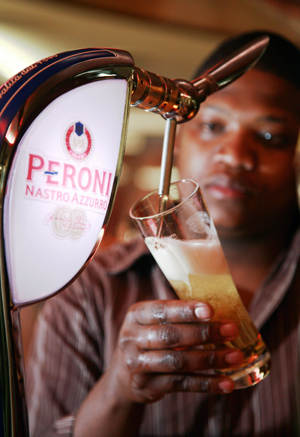Bring out the draught beer
Right. I know the world loves a beer out of a bottle. It’s safe, it’s clean, it’s convenient. But is drinking beer out of a bottle stylish? Classy? Do you want to be caught in the act? Not to mention – does it go with the image, the aspirations of a premium beer brand to be served in bottles which will end up in dirty crates behind the back door? Therefore I’d like to ask you: Isn’t it the ultimate act of cool to be served a freshly tapped beer in a glass?
Granted, there were serious obstacles to selling draught beer in hot climates. Systems were too big and under-used, with wrong settings, insufficient hygiene, and operated by inexperienced staff … But not any longer. Those of you who went to drinktec last year would have seen Micro Matic’s innovative smartDraft system, a genuine “no fuss” unit for outside temperatures of up to 40°C, which takes a lot of worries off brewers’ brows. With its integrated CO2 supply, pre-set temperature and one-way beer line, no one can tamper with it which means that a hygienic, fresh and perfectly cooled draught beer can be served all the time – or until the 10 litre keg is empty.
Moreover, the unit itself, which looks quite neat, can be placed on counter-tops thus offering more advertising space than your average tap handle.
The system which is ideal for small pubs and bars immediately attracted a lot of interest. At drinktec, Micro Matic admitted that Groupe Castel was already rolling out the smartDraft system in its markets in western Africa.
Once Mr Castel thought the smartDraft system was worth his money, SABMiller ran out of reasons to say: “we do not give a d***!”
SABMiller’s South African unit SAB is currently embroiled in a turf war with Heineken and Guinness following their opening of the 3 million hl Sedibeng brewery near Johannesburg in August last year.
According to local media, the battle is heating up over who’s to rule the premium beer segment. Premium beer, which accounts for about 20 percent of South Africa’s 26 million hl beer market, is a hotly contested arena because much of the growth in beer resides in this segment.
Brandhouse Beverages, a three-way joint venture by Diageo, Heineken and Namibia Breweries, is the biggest seller of premium beer, with 56 percent of the segment through Amstel, Heineken, Guinness and Windhoek, and 11.1 percent of the total beer market at the end of November 2009, according to Nielsen data. Heineken’s share, alone, of the premium segment of the market was 13 percent at the end of September.
While SAB has a market share of 88 percent, its offerings in the premium segment are limited to Castle Lite (a brand extension of the mainstream Castle brand), Miller Genuine Draft and Peroni.
The competition between the two companies stems largely from a parting of ways, after SAB had been custodian of several of its rivals’ brands for decades. Growth of the category was driven almost exclusively by the Heineken and Amstel brands, which were managed by SAB until Heineken left SAB in 2003 and Amstel was withdrawn in 2007.
Having a brewery in South Africa allows Heineken and Guinness to penetrate more thoroughly into the urban township market, which used to be a traditional stronghold for SAB.
That’s why I am willing to place my bets on Heineken and Guinness that they will use the official opening of their brewery scheduled for the end of March and the run-up to the Football World Cup to showcase the superior quality of their draught beers by pushing deeper onto SABMiller’s home turf.


